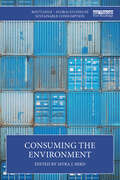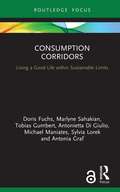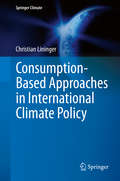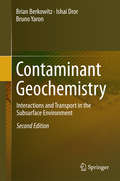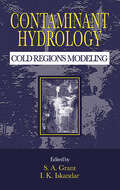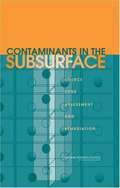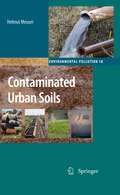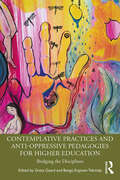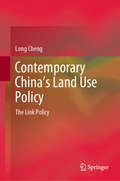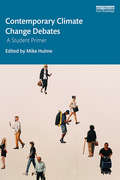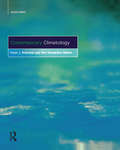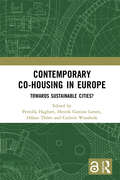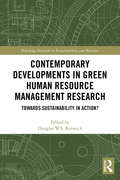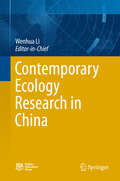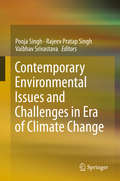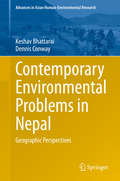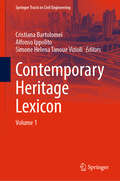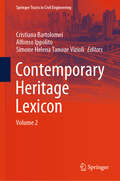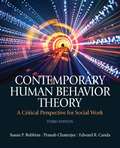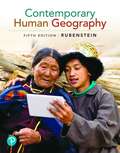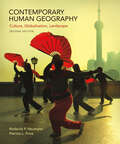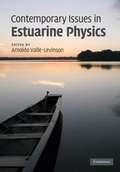- Table View
- List View
Consuming the Environment (Routledge-SCORAI Studies in Sustainable Consumption)
by Myra J. HirdConsuming the Environment explores the environmental impacts of consuming everyday products and explains how we can consume more sustainably.Written in an accessible style, this book begins with our everyday mundane experiences of consuming products – online, in the grocery store, at the mall – and shows how these practices are connected to a global system dependent upon ever increasing consumption. Drawing on the expertise of researchers in topics such as energy, food, water, land, fashion, electronics, eco-tourism, green products, and (micro)plastics, this volume unpacks the complex and largely invisible relationships that consumerism has with resource extraction and manufacturing. By focusing on a diverse range of everyday consumer products, as well as more subtle things that have been transformed into products, such as knowledge, waste, and pets, the chapters are structured around the central argument that we must re-orient ourselves as citizens rather than consumers. It is as citizens that we may help to organize our communities and hold our governments and industry accountable to planetary sustainability boundaries.With the inclusion of summary boxes, directed discussion, assignment questions, and further reading in each chapter, this book will be an essential resource for undergraduate and postgraduate students studying courses on consumerism, sustainable consumption, and environmental sociology.
Consumption Corridors: Living a Good Life within Sustainable Limits (Routledge Focus on Environment and Sustainability)
by Antonia Graf Sylvia Lorek Marlyne Sahakian Antonietta Di Giulio Doris Fuchs Michael Maniates Tobias GumbertConsumption Corridors: Living a Good Life within Sustainable Limits explores how to enhance peoples’ chances to live a good life in a world of ecological and social limits. Rejecting familiar recitations of problems of ecological decline and planetary boundaries, this compact book instead offers a spirited explication of what everyone desires: a good life. Fundamental concepts of the good life are explained and explored, as are forces that threaten the good life for all. The remedy, says the book’s seven international authors, lies with the concept of consumption corridors, enabled by mechanisms of citizen engagement and deliberative democracy. Across five concise chapters, readers are invited into conversation about how wellbeing can be enriched by social change that joins "needs satisfaction" with consumerist restraint, social justice, and environmental sustainability. In this endeavour, lower limits of consumption that ensure minimal needs satisfaction for all are important, and enjoy ample precedent. But upper limits to consumption, argue the authors, are equally essential, and attainable, especially in those domains where limits enhance rather than undermine essential freedoms. This book will be of great interest to students and scholars in the social sciences and humanities, and environmental and sustainability studies, as well as to community activists and the general public.
Consumption-Based Approaches in International Climate Policy (Springer Climate)
by Christian LiningerThis book analyses the potentials and consequences of a change from production-based to consumption-based approaches in international climate policy. With the help of an analytical model, the author investigates the effects of different policy variants on environmental effectiveness, cost-effectiveness, carbon leakage, competitiveness and the global distribution of income. The economic, legal and political background and the often contradictory findings on consumption-based approaches are reviewed in great detail. In the final chapters, options for practical policy design are developed. The book concludes that a switch to consumption orientation is not a policy tool whereby industrialized countries can unilaterally improve climate policy effectiveness, but should rather be seen as a possible intermediate step on the way to a fully multilateral mitigation strategy.
Contact and Symplectic Topology: Lectures From The Nantes Trimester 2011 And The Budapest Summer School 2012 (Bolyai Society Mathematical Studies #26)
by Frédéric Bourgeois Vincent Colin András StipsiczSymplectic and contact geometry naturally emerged from the mathematical description of classical physics. The discovery of new rigidity phenomena and properties satisfied by these geometric structures launched a new research field worldwide. The intense activity of many European research groups in this field is reflected by the ESF Research Networking Programme "Contact And Symplectic Topology" (CAST). The lectures of the Summer School in Nantes (June 2011) and of the CAST Summer School in Budapest (July 2012) provide a nice panorama of many aspects of the present status of contact and symplectic topology. The notes of the minicourses offer a gentle introduction to topics which have developed in an amazing speed in the recent past. These topics include 3-dimensional and higher dimensional contact topology, Fukaya categories, asymptotically holomorphic methods in contact topology, bordered Floer homology, embedded contact homology, and flexibility results for Stein manifolds.
Contaminant Geochemistry: Interactions and Transport in the Subsurface Environment
by Brian Berkowitz Bruno Yaron Ishai DrorIn this updated and expanded second edition, new literature has been added on contaminant fate in the soil-subsurface environment. In particular, more data on the behavior of inorganic contaminants and on engineered nanomaterials were included, the latter comprising a group of "emerging contaminants" that may reach the soil and subsurface zones. New chapters are devoted to a new perspective of contaminant geochemistry, namely irreversible changes in pristine land and subsurface systems following chemical contamination. Two chapters were added on this topic, focusing attention on the impact of chemical contaminants on the matrix and properties of both liquid and solid phases of soil and subsurface domains. Contaminant impacts on irreversible changes occurring in groundwater are discussed and their irreversible changes on the porous medium solid phase are surveyed. In contrast to the geological time scale controlling natural changes of porous media liquid and solid phases, the time scale associated with chemical pollutant induced changes is far shorter and extends over a "human lifetime scale".
Contaminant Hydrology: Cold Regions Modeling
by Ian MuehlenhausEnvironmental contamination in cold regions poses unique problems. It affects traditionally pristine areas and presents substantial operational difficulties. The extreme temperature range, soils and geology, the unique biological diversity, the freezing and thawing of pollutants, and the impact of human activities make environmental site assessment
Contaminants In The Subsurface: Source Zone Assessment And Remediation
by National Research Council of the National AcademiesAt hundreds of thousands of commercial, industrial, and military sites across the country, subsurface materials including groundwater are contaminated with chemical waste. The last decade has seen growing interest in using aggressive source remediation technologies to remove contaminants from the subsurface, but there is limited understanding of (1) the effectiveness of these technologies and (2) the overall effect of mass removal on groundwater quality. This report reviews the suite of technologies available for source remediation and their ability to reach a variety of cleanup goals, from meeting regulatory standards for groundwater to reducing costs. The report proposes elements of a protocol for accomplishing source remediation that should enable project managers to decide whether and how to pursue source remediation at their sites.
Contaminated Urban Soils (Environmental Pollution #18)
by Helmut MeuserThis book gives a current overview of all facets of urban soils. Different urban land-use types in a number of examples worldwide are introduced. Many examples in different countries are provided in order to illustrate the situation in detail. The contaminant sources of urban soils (e.g., dust deposition, contamination along roadsides, contamination of floodplains, application of wastewater, anthropogenic deposits) are comprehensively presented. For practical application purposes a key with which to identify technogenic materials during field work is presented. Features like reductomorphic conditions in landfill soils, acidification of coal mining heaps and the impact of physical characteristics such as sealing are taken into consideration in the context of the contamination problem. The mobility of contaminants in the soils under consideration is introduced and discussed. The content of the book, however, is not limited to the description of contaminated urban soils. Different methods of assessment (classification, functional assessment, assessment focused on pathways with reference to standardized exposure scenarios) are introduced. Finally, quality standards for contaminated land in a number of countries are listed, compared and discussed. The book links up the contamination problem of urban soils with geographical aspects such as the historical development of city growth, the process of urbanization and the urban-to-rural gradients. Accordingly, the reader will be able to understand the specific problems of contaminated urban soils and will find sensible approaches to assessment.
Contemplative Practices and Anti-Oppressive Pedagogies for Higher Education: Bridging the Disciplines
by Greta Gaard Bengü Ergüner-TekinalpThis volume explores mindfulness and other contemplative approaches as strategic tools for cultivating anti-oppressive pedagogies in higher education. Research confirms that simply providing students with evidence and narratives of economic, social, and environmental injustices proves insufficient in developing awareness and eliciting responses of empathy, solidarity, and a desire to act for change. From the environmental humanities to the environmental sciences, legal studies, psychology, and counseling, educators from a range of geographical and disciplinary standpoints describe their research-based mindfulness pedagogies. Chapters explore how to interrupt and interrogate oppression through contemplative teaching tools, assignments, and strategies that create greater awareness and facilitate deeper engagement with learning contents, contexts, and communities. Providing a framework that facilitates awareness of the links between historic and current oppression, self-identity, and trauma, and creating a transformative learning experience through mindfulness, this book is a must-read for faculty and educators interested in intersections of mindfulness, contemplative pedagogies, and anti-oppression.
Contemporary Bamboo Architecture in China
by J. Yang K. W. Liu Q. F. Xu G. Wang F. M. Chen Y. B. Leng K. A. HarriesThis book describes the distribution of bamboo forest and bamboo species for construction, the types and characteristics of both engineered and natural full-culm bamboo materials for construction, the development history and research status of different forms of bamboo architecture. We go on to describe standards, relevant international organizations, research institutions and production and processing enterprises and typical cases. Starting from six aspects, this book systematically describes modern bamboo building development, analyzes the opportunities and challenges faced by the bamboo construction industry and provides guidance for the development of the bamboo construction industry in China. Particularly in Chapter 6, more than 70 examples constructed mostly since 2014 are selected to provide a detailed overview of the use of bamboo as decorative and structural materials. In order to fully explore the potential of bamboo in engineering applications, the authors introduce the use of bamboo construction for transportation facilities (bridges, highway landscape fences and bus stations), landscape, water pipelines and urban municipal tunnels. The authors hope readers are inspired by these most vivid cases and experience the charm of modern Chinese bamboo architecture.
Contemporary China’s Land Use Policy: The Link Policy
by Long ChengThis book discusses contemporary China’s land use policy – the Link Policy – which calls for land consolidation and rural resettlement to achieve the goal of preserving farmland while also providing more space for urban development. Given the limited analyses and commentaries on the Link Policy in the literature, particularly in English-language articles, the book systematically presents and analyzes China’s land use policy by assessing the impacts of the Link Policy on rural life and how effective the Link Policy is in achieving its objectives. It also examines how satisfied farmers are with the policy and what the contributing factors are.Drawing on a critical review of the literature, field observations and interviews with resettled farmers, the book offers insights into China’s land use policy, and compares it with similar policy instruments in other countries. Presenting research findings that help readers gain a holistic understanding of the Link Policy in China and its implications, the book is a valuable resource for professionals in other developing countries that are facing similar challenges in terms of balancing urban development and farmland conservation.
Contemporary Climate Change Debates: A Student Primer
by Mike HulmeContemporary Climate Change Debates is an innovative new textbook which tackles some of the difficult questions raised by climate change. For the complex policy challenges surrounding climate migration, adaptation and resilience, structured debates become effective learning devices for students. This book is organised around 15 important questions, and is split into four parts: What do we need to know? What should we do? On what grounds should we base our actions? Who should be the agents of change? Each debate is addressed by pairs of one or two leading or emerging academics who present opposing viewpoints. Through this format the book is designed to introduce students of climate change to different arguments prompted by these questions, and also provides a unique opportunity for them to engage in critical thinking and debate amongst themselves. Each chapter concludes with suggestions for further reading and with discussion questions for use in student classes. Drawing upon the sciences, social sciences and humanities to debate these ethical, cultural, legal, social, economic, technological and political roadblocks, Contemporary Debates on Climate Change is essential reading for all students of climate change, as well as those studying environmental policy and politics and sustainable development more broadly.
Contemporary Climatology
by Ann Henderson-Sellers P.J. RobinsonNow in its second edition,Climatology continues to provide an up-to-date stimulating and comprehensive guide to the nature of the earth's climate. It presents a synthesis of contemporary scientific ideas about atmospheric circulation. Topics covered include:-Energy systems-The hydrological cycle-General circulation, local and regional climate-Application of climate information-Use of satellite observations
Contemporary Co-housing in Europe (Open Access): Towards Sustainable Cities?
by Hakan Thorn Henrik Gutzon Larsen Cathrin Wasshede Pernilla HagbertThis book investigates co-housing as an alternative housing form in relation to sustainable urban development. Co-housing is often lauded as a more sustainable way of living. The primary aim of this book is to critically explore co-housing in the context of wider social, economic, political and environmental developments. This volume fills a gap in the literature by contextualising co-housing and related housing forms. With focus on Denmark, Sweden, Hamburg and Barcelona, the book presents general analyses of co-housing in these contexts and provides specific discussions of co-housing in relation to local government, urban activism, family life, spatial logics and socio-ecology. This book will be of interest to students and researchers in a broad range of social-scientific fields concerned with housing, urban development and sustainability, as well as to planners, decision-makers and activists.
Contemporary Developments in Green Human Resource Management Research: Towards Sustainability in Action? (Routledge Research in Sustainability and Business)
by Douglas W.S. RenwickThis book examines a new topic in Human Resource Management (HRM), green – or environmental – HRM, analysing the role humans play in environmental management at work and environmental behaviours at workplaces around the world. The book begins with a focus on negative workplace green behaviours (e.g. toxic chemical leaks, air pollution, contaminated waste etc.), and what such environmental problems mean for workers, managers and society as a whole. This book outlines relevant, underpinning academic theory and research literature on how HRM is ‘going green’, and details real-life organisational examples derived from original and secondary empirical research to illuminate the implications of adopting Green HRM practices for relevant stakeholders. In doing so, the book offers a new, academic contribution to both the HRM and environmental management literatures.
Contemporary Ecology Research in China
by Wenhua LiThe Chinese government is increasingly focusing on ecological construction and has subscribed to a national "Ecological Civilization Construction". Ecological research and protection practice develop so fast and achieve a lot at the national agenda. This book is a synthesis of five most exciting and dominant themes in contemporary ecological research in China: biodiversity, ecosystem management, degraded ecosystem restoration, global change and sustainable development. This book spans all the Earth's major ecosystems, such as forests, oceans, grasslands, wetlands, lakes, rivers, farmland and cities. This book provides a platform for scientific research across a variety of disciplines. It will be invaluable to experts, policymakers and local officers and will also be a highly useful resource for undergraduate and postgraduate students. This book will allow researchers, students and policymakers outside China to learn abou t the significant achievements and applications of ecological research within China.
Contemporary Environmental Issues and Challenges in Era of Climate Change
by Rajeev Pratap Singh Pooja Singh Vaibhav SrivastavaOver the last few decades, unprecedented global population growth has led to increased demand for food and shelter. At the same time, extraction of natural resources beyond the Earth’s resilience capacity has had a devastating effect on ecosystems and environmental health. Furthermore, climate change is having a significant impact in a number of areas, including the global hydrological cycle, ecosystem functioning, coastal vulnerability, forest ecology, food security, and agricultural sustainability. According to the Intergovernmental Panel on Climate Change (IPCC), only immediate and sustained action will prevent climate change causing irreversible and potentially catastrophic damage to our environment. This book presents various scientific views and concepts, research, reviews, and case studies on contemporary environmental issues in changing climate scenarios and highlights different adaptation measures. Increasing awareness of modern-day patterns of climate change, it addresses questions often raised by environmental scientists, researchers, policymakers and general readers.
Contemporary Environmental Problems in Nepal: Geographic Perspectives (Advances in Asian Human-Environmental Research)
by Dennis Conway Keshav BhattaraiThis monograph examines contemporary environmental challenges facing Nepal, this landlocked country’s representativeness in the wider South Asian context is both distinct and generalizable. In large part, this is because of its extremes of physiographical structure- plains, hill ranges, mountainous massifs - and wide range of altitudinal terrains, which represent and replicate South Asian and East Asian continental conditions differing as markedly as humid tropical lowlands, sub-tropical hill ranges and temperate to sub-arctic mountainous environments. Associated forest regimes, in which deforestation and reforestation patterns have evolved in recent times, and differing densities of settlement and cleared agricultural landscapes in each of these altitudinal zones, add to the environmental diversity of Nepal. Associated fauna and exotic species are in various states of endangerment especially Bengal tigers, one horned rhinos, wild elephants, crocodile, musk deer, and peasants, to name a few- so that their forested and mountainous habitats as ‘Wild Life Reserves’ also deserve our attention, and are featured in this monograph’s remit.
Contemporary Environmentalists
by Kevin GrahamHere are ten men and women whose contributions to the environmental movement have significantly changed how we see and think about the world. Profiles: Jacques-Yves Cousteau, Anita Roddick, Vo Quy, Neca Marcovaldi, David Brower, Thomas Odhiambo, Gro Harlem Brundtland, Randy Hayes, Joseph Krecek, and Michael Bloomfield.
Contemporary Heritage Lexicon: Volume 1 (Springer Tracts in Civil Engineering)
by Cristiana Bartolomei Alfonso Ippolito Simone Helena Tanoue VizioliThis book presents themes related to contemporary architecture as the results of diverse cultural influences and architectural legacies, manifested in a rich variety of styles, materials, and spatial perceptions. It consists of 24 chapters written by authors from various continents and contains the result of research highlighting contemporary architecture in relation to multiple aspects that are distinguished by their eclectic nature, characterized by the integration of diverse cultural and architectural influences. The book examines aspects involving material aspects, technologies, design, history, salvage, technologies, and digitization. The aspects covered are always filtered through research, which objectively integrates traditional and innovative approaches. Thus, the focus is to explore the contemporary lexicon not only in the field of architecture and engineering, but in all those areas where this theme can be read with a meaningful vision. Contemporary architecture is constantly evolving, reflecting the changing needs of society and anticipating the challenges of the future.
Contemporary Heritage Lexicon: Volume 2 (Springer Tracts in Civil Engineering)
by Cristiana Bartolomei Alfonso Ippolito Simone Helena Tanoue VizioliThe book presents themes related to contemporary architecture as the results of diverse cultural influences and architectural legacies, manifested in a rich variety of styles, materials, and spatial perceptions. It consists of 24 chapters written by authors from various continents and contains the result of research highlighting contemporary architecture in relation to multiple aspects that are distinguished by their eclectic nature, characterized by the integration of diverse cultural and architectural influences. The book examines aspects involving material aspects, technologies, design, history, salvage, technologies, and digitization. The aspects covered are always filtered through research, which objectively integrates traditional and innovative approaches. Thus, the focus is to explore the contemporary lexicon not only in the field of architecture and engineering but in all those areas where this theme can be read with a meaningful vision. Contemporary architecture is constantly evolving, reflecting the changing needs of society and anticipating the challenges of the future.
Contemporary Human Behavior Theory: A Critical Perspective for Social Work
by Susan P. Robbins Pranab Chatterjee Edward R. CandaContemporary Human Behavior Theory: A Critical Perspective for Social Work, 3e approaches HBSE from a comparative theory perspective, providing coverage of the most current and contemporary theories as well as traditional theories. It includes contemporary developments in traditional lifespan theory, theories of political economy, and a separate chapter on transpersonal theory. Each chapter includes coverage of the research that supports a particular theory, an analysis of the validity of that research, and a discussion of updated "Contemporary Issues. " The text encourages students to develop critical thinking skills in analyzing and comparing theories.
Contemporary Human Geography
by James M. RubensteinContemporary Human Geography incorporates a bold, highly visual approach to guide you in exploring physical and cultural landscapes across the globe. The modular organization and vibrant presentations work together to focus and engage you. Rubenstein describes past and current events and issues to show how their influence on diversity and globalization phenomena are at the core of contemporary human geography. The 5th Edition presents the latest geographical science and statistics, including current data on recent events. This edition incorporates applied examples of human geography, guiding you to understand the world on local, regional and global scales.
Contemporary Human Geography: Culture, Globalization, Landscape
by Roderick Neumann Patricia PriceWith each chapter organized by five themes (region, mobility, globalization, nature-culture, cultural landscape), Contemporary Human Geography introduces students to geography concepts through fascinating topics such as the distribution of college sports, the relationship of beauty pageants and cultural identity, texting and language modification, and more, continually reinforcing geographers’ contributions to our understanding of how we live in a globalized, modern world. The authors frame this coverage using specific learning objectives to help students focus on essential concepts and prepare for class discussions, assignments, and exams. Contemporary Human Geography comes with two of Macmillan’s online course spaces, allowing instructors to choose how much media and assessment they’d like to make available for their students, and at what price point. SaplingPlus offers innovative media content, curated assessments, and brand new mapping activities powered by Esri. Achieve Read & Practice combines the accessibility of a VitalSource e-book with our self-paced, formative quizzing engine, LearningCurve.
Contemporary Issues in Estuarine Physics
by A. Valle-LevinsonEstuaries are of high socioeconomic importance with 22 of the 32 largest cities in the world located on river estuaries. Estuaries bring together fluxes of fresh and saline water, as well as fluvial and marine sediments, and contain high biological diversity. Increasingly sophisticated field observation technology and numerical modeling have produced significant advances in our understanding of the physical properties of estuaries over the last decade. This book introduces a classification for estuaries before presenting the basic physics and hydrodynamics of estuarine circulation and the various factors that modify it in time and space. It then covers special topics at the forefront of research such as turbulence, fronts in estuaries and continental shelves, low inflow estuaries, and implications of estuarine transport for water quality. Written by leading authorities on estuarine and lagoon hydrodynamics, this volume provides a concise foundation for academic researchers, advanced students and coastal resource managers.
